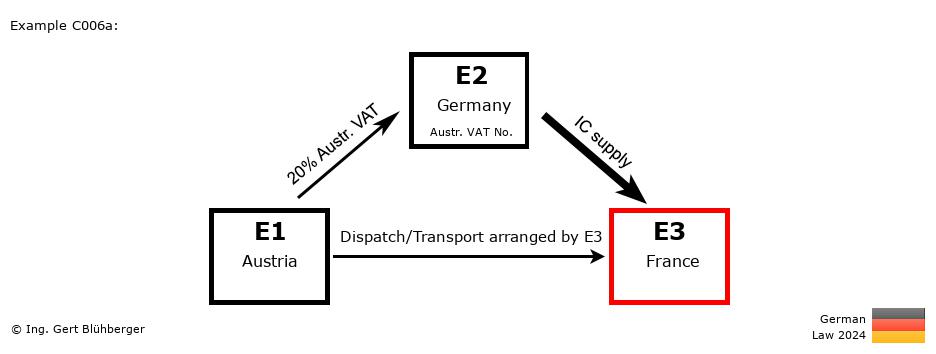Facts:
A French entrepreneur E3 (= last purchaser) orders a machine at his German supplier E2 (=1st purchaser). Since the supplier E2 does not have the machine in stock, he orders it from the Austrian wholesaler E1 (= first supplier).
The French entrepreneur E3 picks up of the machine from the Austrian wholesaler E1. Brief description of the chain transaction:
- Registration obligations:
- The German entrepreneur E2 has to obtain a VAT registration in the country of departure (Austria). (no triangular transaction!)
- "Supply 1" from E1 (Austria) to E2 (Germany)
- Transaction without transport/dispatch assignment (§ 3 (7) UStG)
- Taxable supply in Austria (E1)
- "Supply 2" from E2 (Germany) to E3 (France)
- Assignment of transport or dispatch according to § 3 (6) UStG in conjunction with § 3 (6a) sentence 3 UStG
- VAT-exempt supply in Austria (E1)
- Tax exemption pursuant to § 4 (1)(b) UStG in conjunction with § 6a UStG (intra-Community supply)
Detailed description from the perspective of the individual entrepreneurs: From the perspective of the 1st supplier E1 (from Austria): From the perspective of the 1st supplier E1 (from Austria):
Outgoing Invoice:
- Invoicing:
This supply is taxable in Austria (E1). The invoice must therefore be issued with 20 % Austrian VAT, stating the own (Austrian) VAT identification number.
- VAT Return:
Declaration of the sales transaction as a taxable (domestic) supply.
 From the perspective of the 1st purchaser E2 (from Germany): From the perspective of the 1st purchaser E2 (from Germany):
Registration obligations:- The German entrepreneur E2 has to obtain a VAT registration in the country of departure (Austria) and act with his Austrian VAT identification number towards E1 and E3. The entries listed below are consequently to be included in the Austrian VAT return, ESL and Intrastat SD.
Incoming Invoice:
- VAT return (at the Austrian Tax Office):
The Austrian VAT contained in the incoming invoice can be deducted as input tax and must be included in the VAT return accordingly.
Outgoing Invoice:
- Invoicing:
Invoice without VAT with reference to the tax exemption (intra-Community supply) pursuant to § 4 (1)(b) UStG in conjunction with § 6a UStG (or alternatively with reference to Article 138 of the Directive 2006/112/EC) and specification of the own Austrian VAT identification number as well as the (French) VAT identification number of the French entrepreneur E3.
- VAT Return (at the Austrian Tax Office):
Declaration of the sales transaction as an intra-Community supply.
- EC Sales List (at the Austrian Tax Office):
Declaration as (intra-Community) supply to the (French) VAT identification number of the French entrepreneur E3.
- Intrastat Supplementary Declaration (at the Austrian authority):
Declaration as dispatch to France. Since 2022, the country of origin and the (French) VAT identification number of the French entrepreneur E3 must also be reported.
 From the perspective of the last purchaser E3 (from France): From the perspective of the last purchaser E3 (from France):
Incoming Invoice:
- VAT return:
The incoming invoice contains no VAT and is to be included as an intra-Community acquisition in the VAT return. Therefore, on the one hand, the VAT (acquisition tax) must be paid and, on the other hand, it can be treated as input tax on the same return.
- Intrastat Supplementary Declaration (Intrastat SD):
Declaration as arrival from Austria.
Notes to the chain transaction:
- Triangular transactions require that either the first supplier (E1) or the first purchaser (E2) arrange the transport. In the above case, however, the transport is arranged by the last purchaser (E3). Therefore, the simplification rules of the triangular transaction cannot be applied and the entrepreneur E2 has to obtain a VAT registration in the country of departure (Austria). You find the exact requirements for the applicability of the simplification rules for triangular transactions at www.triangular-transaction.de.
- The above detailed descriptions from the perspective of the individual entrepreneurs represent only an indication of how the tax assessment would be if the German laws were to apply in Austria and in France. National deviations from the German legislation were also not taken into account in the chain transaction sketch and the brief description!
- In addition to the entries in the VAT return as stated above, the German entrepreneur E2 must record in the German VAT return in line 36/code 45 supplies that are not taxable in Germany whose place of supply is outside Germany and which would be taxable if they would be carried out within the country. This applies not only to supplies that are subject to VAT, but also to tax-exempt transactions such as intra-Community supplies.
- You can find the German version in the reihengeschaeftrechner.de.
- The assessment of this chain transaction from the Austrian perspective you can find in the reihengeschaeftrechner.at.
Please note the Terms of Use and the Disclaimer of Liability. |

